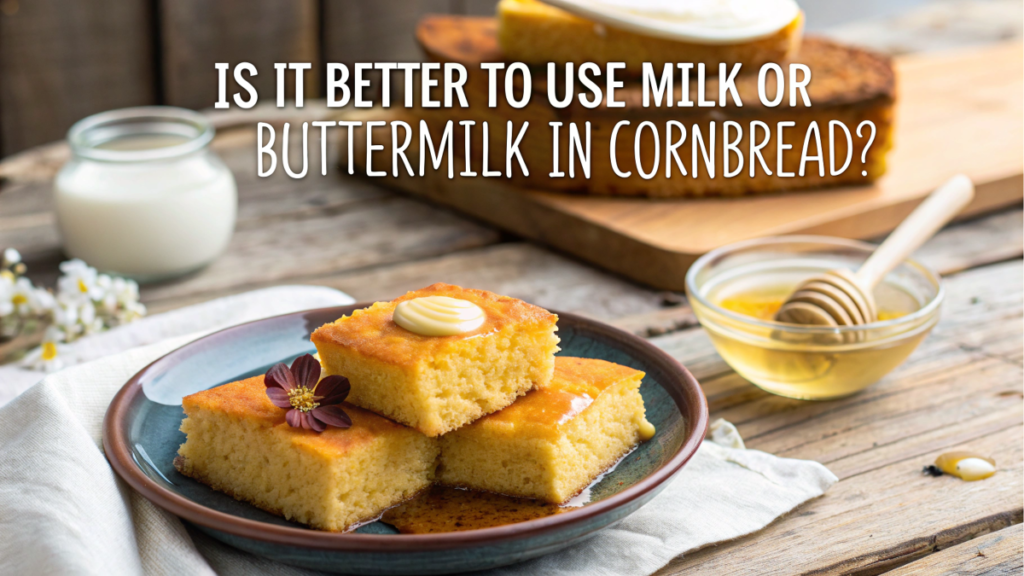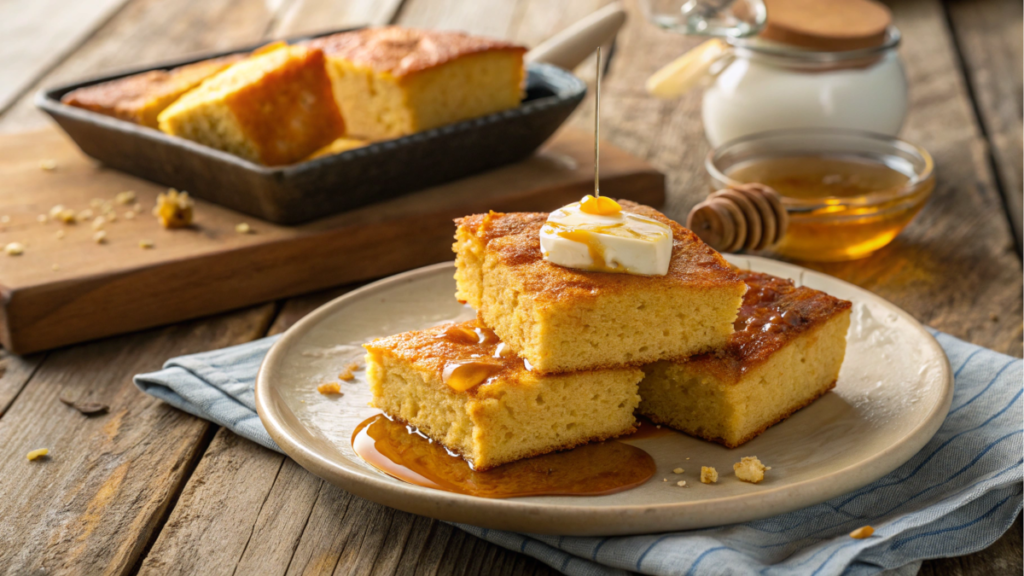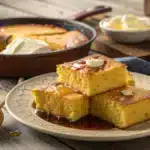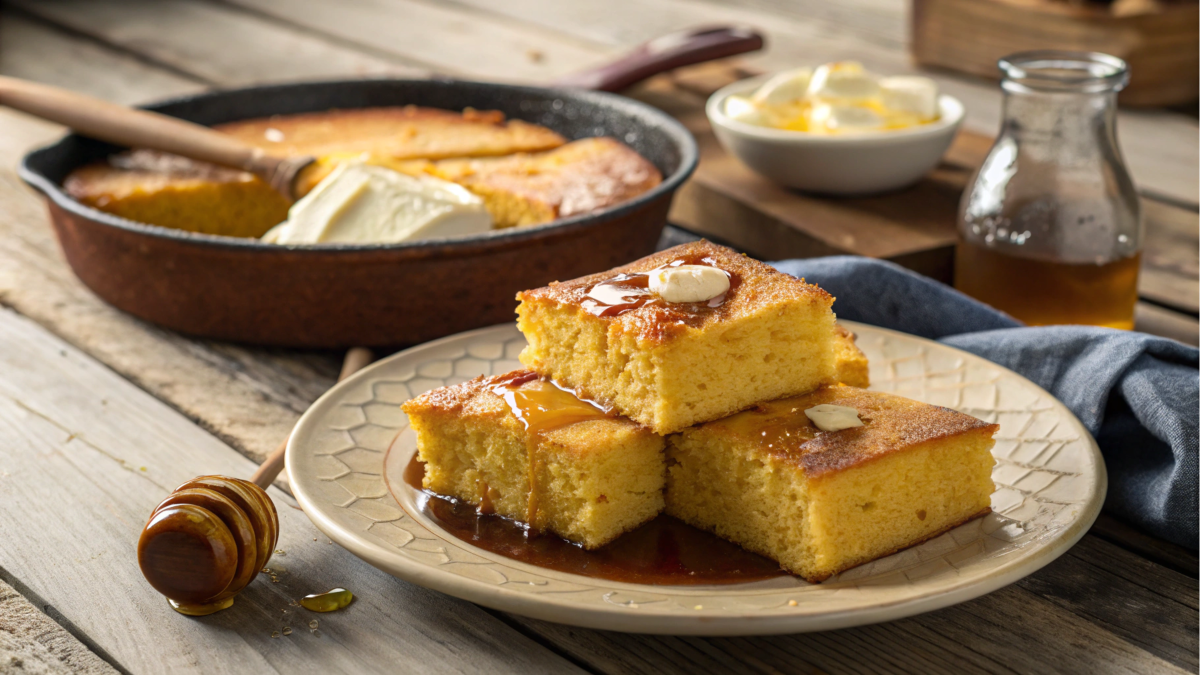Written by Sarah Miller
Cornbread has a unique area on many tables, whether or not it’s served along a bowl of chili or as a holiday aspect dish. But right here’s the age-vintage question: Is it better to use milk or buttermilk in cornbread? The answer might depend on your flavor buds, circle of relatives traditions, or even what is already in your refrigerator. In this article, we’ll dive into the key variations between milk and buttermilk in cornbread recipes, how they have an effect on texture and taste, and hints for making the fine desire to your next batch. Let’s get commenced!
Introduction to Cornbread and Its Ingredients
The Significance of Cornbread in American Cuisine
Cornbread isn’t simply some other aspect dish—it’s a slice of records. This humble bread lines its roots returned to Native American cooking, where cornmeal become a staple aspect. Over the years, it became a cornerstone of Southern cooking and subsequently determined its manner to kitchens all across the U.S. From sweet, cake-like variations to savory, crumbly loaves, cornbread has a manner of bringing consolation to the desk.
Traditional Ingredients Used in Cornbread Recipes
The fundamental components for cornbread are quite simple: cornmeal, flour, eggs, and some form of liquid like milk or buttermilk. But, relying on wherein you’re from—or who taught you the way to prepare dinner—you might see recipes calling for sugar, butter, or maybe bacon grease! These little tweaks can completely change the taste and texture, but the liquid is wherein the actual magic happens.
Milk brings a impartial, creamy base, while buttermilk provides a tangy twist and works wonders with leavening sellers like baking soda. (We’ll communicate more approximately that later!) Whether you want your cornbread candy or savory, the choice among milk and buttermilk plays a massive function in getting it just right.
Understanding Milk and Buttermilk
Composition and Characteristics of Regular Milk
Milk is a kitchen staple, and it’s the pass-to liquid for many cornbread recipes. With its slight flavor and smooth consistency, milk adds just enough moisture to bind the substances and maintain your cornbread smooth. Most recipes call for complete milk, which has a balanced fats content that complements the feel with out being overly heavy.
But here’s the aspect—milk doesn’t bring lots to the birthday party flavor-wise. It maintains matters easy, which can be notable in case you’re pairing cornbread with ambitious dishes like BBQ or highly spiced chili. Plus, in case you’ve were given a carton in the fridge already, it’s a no-brainer for comfort.
Composition and Characteristics of Buttermilk
Buttermilk, on the other hand, is an entire extraordinary tale. It’s thicker, tangier, and slightly acidic. Traditional buttermilk changed into a byproduct of churning butter, but nowadays, it’s usually cultured, which means it’s made via adding micro organism to exploit. Sounds fancy, proper? But accept as true with me, it’s not—think of it because the sour cream of the milk world.
Buttermilk’s acidity reacts with baking soda or powder, creating fluffy cornbread with the right density. Its tangy flavor adds a delightful zing.
Key Differences Between Milk and Buttermilk
When it comes to cornbread, the selection between milk and buttermilk boils right down to texture and taste. Milk continues it honest, whilst buttermilk brings tang and fluff. Think about what you’re craving, and that’ll manual your preference.
Impact on Cornbread Texture and Flavor
How Milk Affects Cornbread Texture and Taste
Milk gives cornbread a easy, tender texture. It’s perfect if you’re aiming for some thing light and fluffy but no longer too crumbly. Since milk has a impartial taste, it we could the other ingredients—like cornmeal and butter—shine. If you opt for sweeter cornbread, milk is a splendid desire as it balances properly with sugar or honey with out adding any competing tanginess.
However, milk doesn’t come up with that identical wealthy depth of flavor as buttermilk. The texture can also feel a piece drier, especially if the recipe doesn’t include enough fat. But howdy, it’s a conventional for a purpose—it gets the process done, and it’s a dependable choice whilst you want straightforward, no-fuss cornbread.
How Buttermilk Influences Cornbread Texture and Taste
Now, let’s speak about buttermilk. If you’ve ever bitten into cornbread that’s smooth, wet, and just a little tangy, probabilities are it turned into made with buttermilk. That acidic punch doesn’t just add taste—it interacts with baking soda or baking powder to give your cornbread a nice rise. This means you’ll get a slightly denser, richer texture, that is best for hearty dishes like stews or gumbo.
The tangy flavor is the star right here. It brings a savory vibe that’s hard to conquer, mainly if you’re skipping the sugar and going for a greater traditional Southern cornbread. But, heads up: if you’re not partial to tanginess, you would possibly discover it a chunk overpowering.
Comparative Analysis: Milk vs. Buttermilk in Cornbread
When it comes to milk vs. buttermilk in cornbread, the choice hinges for your possibilities. Want mild and sweet? Go with milk. Craving moist, tangy, and rich? Buttermilk’s your pleasant guess. Both have their perks, and the right one for you may depend on what you’re serving with it.
Leavening Agents and Their Interaction with Milk and Buttermilk
Role of Baking Soda and Baking Powder in Cornbread
Leavening sellers like baking soda and baking powder are the unsung heroes of cornbread. Without them, your bread would flip out flat and dense—nobody wishes that! These substances assist the batter rise via developing tiny air wallet, giving cornbread its tender and fluffy texture.
The desire among baking soda or baking powder depends at the acidity of the liquid you’re the use of. And right here’s in which the milk vs. Buttermilk debate without a doubt comes into play.
Chemical Reactions Between Leavening Agents and Milk
Milk is neutral, so it really works fine with baking powder, which has its personal acidic factor to kickstart the growing procedure. When you mix milk and baking powder, you’ll get a gentle raise that outcomes in a classic, even-textured cornbread. It’s predictable and reliable, making it best for beginners or individuals who like to stick to standard recipes.
That stated, if your recipe calls for baking soda and also you’re using milk, you’ll want to feature an acidic ingredient—like vinegar or lemon juice—to cause the reaction.
Chemical Reactions Between Leavening Agents and Buttermilk
Buttermilk, being clearly acidic, pairs like a dream with baking soda. When these two team up, it’s like a mini science experiment in your blending bowl. The acid in buttermilk turns on the baking soda right now, producing bubbles that make the batter rise beautifully. The result? Fluffy, gentle cornbread with a touch of tang.
Using buttermilk and baking soda can increase your cornbread to the subsequent level (oops, no longer that phrase!). It’s a foolproof way to acquire a wealthy, wet texture that feels love it got here immediately out of grandma’s oven.
Nutritional Differences and Health Considerations

Nutritional Profile of Cornbread Made with Milk
Cornbread made with milk has a tendency to have a slightly lighter dietary profile. Regular milk, mainly low-fat or skim milk, has fewer calories and less fat compared to buttermilk. This makes it an excellent desire in case you’re looking to keep things at the healthier aspect with out sacrificing taste. Milk also provides calcium, vitamin D, and protein, all of which can be tremendous for constructing strong bones and muscles.
However, cornbread made with milk may lack some of the richness and intensity of taste which you’d get with buttermilk. If you’re the usage of entire milk, the greater fat content material can help balance this out, supplying you with a barely creamier texture.
Nutritional Profile of Cornbread Made with Buttermilk
Buttermilk is probably tangy, however it’s pretty low in fats. Most save-offered variations are crafted from low-fats or skim milk, so they’re lighter than you might suppose. Buttermilk additionally contains probiotics—those “desirable micro organism” which can assist with digestion. If you’re into intestine fitness, this is probably a massive win.
Cornbread made with buttermilk tends to experience more indulgent, way to its thicker consistency and tangy flavor. But don’t allow that fool you into questioning it’s less wholesome! It’s all about balance, and buttermilk brings plenty to the desk nutritionally.
Health Implications of Choosing Milk or Buttermilk
The desire between milk and buttermilk ultimately depends for your dietary desires. Want a lighter choice? Stick with milk. Looking for taste and delivered advantages like probiotics? Buttermilk is a strong pick. Either way, cornbread can in shape right into a balanced weight loss program—just watch the element sizes in case you’re including butter or extra toppings!
Regional Preferences and Traditional Practices
Southern Cornbread Traditions and the Use of Buttermilk
In the South, cornbread is almost a religion—and buttermilk is its holy grail. Southern-fashion cornbread is normally savory, with little to no sugar, and baked to perfection in a forged iron skillet. Buttermilk is a conventional ingredient because it brings that signature tangy taste and a wet, dense texture that Southerners love.
Traditionally, Southern cooks used what that they had accessible, and buttermilk turned into a staple in many kitchens. Its acidity additionally helped stability the flavors of dishes like collard greens or black-eyed peas, making it the pass-to desire for generations. Plus, while it’s cooked in a skillet, the edges get splendidly crispy—a trademark of real Southern cornbread.
Northern Cornbread Variations and the Use of Milk
Head up North, and you’ll locate cornbread that’s sweeter, lighter, and regularly made with milk. Northern-fashion cornbread is more like cake than bread, with sugar or honey introduced to the batter for extra sweetness. Milk complements this style beautifully, allowing the flavors to shine through without any distractions.
Unlike its Southern cousin, Northern cornbread is often baked in a ordinary pan in preference to a skillet, giving it a softer crust. Milk’s versatility makes it a favorite right here, in particular for people who love to pair their cornbread with chili or soups.
Cultural Significance of Ingredient Choices in Cornbread
Whether you use milk or buttermilk, your desire says lots about in which you’re from—or how you grew up. These factor options are steeped in way of life, displaying how meals connects us to our roots while still leaving room for private twists.
Practical Tips for Choosing Between Milk and Buttermilk
Factors to Consider When Selecting Ingredients
When determining among milk and buttermilk to your cornbread, think about what you’re going for. Do you want it candy or savory? Light or dense? Buttermilk is good if you love a tangy kick and a wealthy texture—it’s perfect for traditional Southern recipes. On the opposite hand, in case you’re preserving things mild and straightforward, milk is your exceptional bet.
Also, keep in mind what you’ve were given within the fridge. If you don’t have buttermilk on hand, don’t stress. Milk works simply best, and you could tweak your recipe to get incredible outcomes.
How to Substitute Milk for Buttermilk and Vice Versa
Need buttermilk however best have milk? No hassle! Add a tablespoon of lemon juice or white vinegar to a cup of milk and allow it sit for 5–10 minutes. Voilà—you’ve got a buttermilk alternative!
If you’re out of milk and all you’ve were given is buttermilk, you may use it as a substitute, but you may need to reduce the baking soda on your recipe to keep away from an excessive amount of acidity.
Recipe Adjustments for Optimal Results
No count which liquid you pick, the secret’s stability. If your batter seems too thick, add a touch of milk or water to skinny it out. For greater flavor, toss in a bit of melted butter or a spoonful of bitter cream. And don’t forget about to preheat your skillet—it’s the secret to a crispy, golden crust.
By retaining these suggestions in mind, you’ll nail your cornbread every time, whether you’re crew milk or buttermilk.
Which Is Better for Cornbread?
Summary of Key Points
So, is it higher to use milk or buttermilk in cornbread? The solution definitely relies upon on what you’re seeking out. Milk gives you a mild, fluffy texture with a neutral flavor, making it best for sweeter, Northern-fashion cornbread. Buttermilk, then again, brings a tangy flavor and a moist, dense texture that’s best for conventional Southern recipes.
We’ve additionally found out that buttermilk works magic with baking soda, creating a fluffier upward thrust, at the same time as milk is a strong preference for recipes relying on baking powder. Both alternatives convey their personal strengths, so you without a doubt can’t go incorrect—it’s all approximately personal flavor and what’s handy.
Final Recommendations Based on Analysis
If you want to paste to way of life, go along with buttermilk for a wealthy, savory loaf. But in case you decide upon a sweeter, cake-like cornbread—otherwise you don’t have buttermilk accessible—milk is a awesome alternative. And don’t neglect, you may continually make your own buttermilk alternative in case you’re in a pinch.
At the end of the day, cornbread is as flexible as it’s far scrumptious. Whether you’re crew milk or buttermilk, the most crucial issue is taking part in a warm slice with the humans you love.
Frequently Asked Questions (FAQs)

Can I Use Buttermilk Instead of Milk in Cornbread?
Absolutely! Buttermilk is a terrific replacement for milk in cornbread recipes. Just hold in thoughts that its acidity will react with baking soda or baking powder, that could alternate the texture barely. If your recipe makes use of baking powder, you would possibly want to cut back on it or balance things out with a pinch of baking soda.
How Does Buttermilk Affect the Texture of Cornbread?
Buttermilk makes cornbread more wet and gentle, thanks to its acidity and thicker consistency. It also facilitates create a fluffier rise when paired with baking soda, giving you a denser but gentle loaf. The tangy taste is an advantage for those who decide upon savory cornbread.
Is It Possible to Make Cornbread Without Dairy?
Yes, you may make cornbread with out dairy by the use of plant-based milk (like almond or soy milk) or a vinegar-and-water mixture to imitate buttermilk. Coconut milk works too however adds a touch of sweetness.
What Are Some Vegan Alternatives to Milk and Buttermilk in Cornbread?
For a vegan twist, try almond milk mixed with lemon juice as a buttermilk substitute. Oat milk or soy milk additionally work first-rate, specifically in recipes that lean toward the sweeter side.

Cornbread
Ingredients
Dry Ingredients
- 1 cup cornmeal Use fine or medium grind for the best texture.
- 1 cup all-purpose flour For a lighter texture, consider using cake flour.
- 1 tbsp baking powder This helps the bread rise.
- 1/2 tsp salt Enhances flavor.
Wet Ingredients
- 1 cup buttermilk or milk Choose based on desired taste: buttermilk for tangy flavor, milk for sweetness.
- 1/4 cup melted butter Adds richness and flavor.
- 1 large egg Binds the ingredients.
Instructions
Preparation
- Preheat your oven to 400°F (200°C) and grease a baking dish or cast iron skillet.
- In a large bowl, mix together cornmeal, flour, baking powder, and salt.
- In another bowl, whisk together buttermilk (or milk), melted butter, and egg until well combined.
Mixing
- Pour the wet ingredients into the dry ingredients and stir until just combined. Be careful not to overmix.
Baking
- Pour the batter into the prepared baking dish and smooth the top.
- Bake for 20-25 minutes or until golden brown and a toothpick inserted into the center comes out clean.
